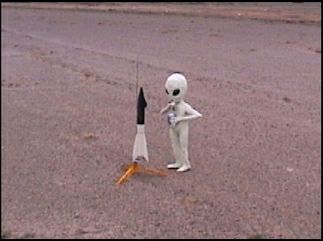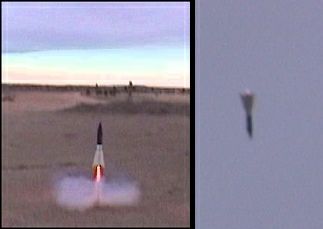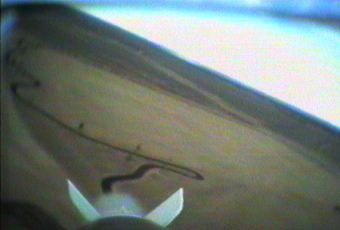2.24.2001
The Roswell launch site
Roswell Vidroc Flight Notes
2.24.2001
The Roswell launch site
Vidroc 1.5 (unrecorded flight 4)
Well, just about everything that could go wrong did. In fact because this flight was a total washout, I didn't list it in the flight reports.
 (Here's Schwa doing a pre-flight inspection.) |
The Vidroc 1.5 was fitted with a new harness to hold the camera at a slight angle during
recovery.
I flew it single stage and put a D12-5 in it because in past flights this proved to catch the apogee just right.
|
 |
The flight was stable and high, but unfortunately
the delay charge took WAY too long and the ejection charge
blew while the rocket was already making a speedy
decent.
This resulted in too much stress on the camera's parachute when it opened, and thus caused the harness to break and the camera to free-fall. |
|
Vidroc 2.0 flight #1 (Roswell Flight 2)
Note the Hot Air Balloon on the horizon. |
For the first flight of Vidroc 2, I decided to go with 2 stages, using a D12-5 for the upper stage. The system went together nicely and flew straight as an arrow.
|
| The Video Walkman was recording this time
and captured the Vidroc's camera data!
This footage is at 1/2 speed and clearly shows the staging! I overlaid two time counters, one that starts at launch and the second that starts when the first stage drops off. It's interesting to note the second
stage recovery charge happens at 6+ seconds, more than a full second
late. Though I didn't observe this behavior right away, this turned out to be a consistent problem at Roswell. It makes me wonder if the higher altitude (3573 feet) at the launch site causes the motors to deliver a later ejection charge. Certainly shouldn't be that way, but for now that's the only explanation I can come up with. Thanks to the altimeter on board, we know it flew to 611 feet! If you listen closely (the audio gets a little scrambled) you can make out the "6-1-1" chirping on the video, just after the parachutes are deployed.
|
|
Because I had wanted to save weight, I had rigged the altimeter to use the same battery power as the camera. This had two drawbacks; one, I had to wait for the altimeter to be ready before we could launch (about 20 seconds) and two, it caused the batteries to die out sooner. As soon as the system was on the ground it no longer had enough power to keep the altimeter beeping, but because it was all recorded we could tell how high it went by listening to the video playback. |
Vidroc 2.0 flight #2 (Roswell Flight 3)
Things were looking great, so we decided to send Vidroc 2 back up, this time putting a separate battery into the altimeter so it wouldn't delay the launch and not pull down the power for the camera.
| Altimeter on, Video Walkman On, Vidroc 2 On Launch!
Well that was about as good as that flight got. The rocket vectored off shortly after leaving the launch pad and was heading straight for a near by hot air balloon! It looked as though I had aimed for the damn thing!
|
|
I can only blame the design of the launch vehicle; perhaps the long fins on the upper stage introduce this flight characteristic. I'm going to redesign this aspect of the system and go with a more traditional layout.
|
|
 |
Roswell
Flight 3 AVI (5.5mb DivX codec)
The Video signal from the system went out once the rocket was down range and the antennas weren't aligned, so I don't have any video data from the rocket regarding when the ejection charge blew (or tried to). |
Flight 3 ground tracking AVI (0.9mb DivX codec) In studying the ground tracking video, the ejection charge should have blown while the rocket was still airborne. It's possible the nose cone was stuck, but that wasn't easy to tell from the wreckage.
|
| Needless to say, it continued to arc and
the rocket impacted at a low angle.
|
|
|
Roswell Flights epilog: We came, we launched, we crashed. The Vidroc 2 sliding mirror system performed well (at least on its first flight) and I plan to rebuild it for future flights. The mirror release system may have caused the nose cone to jam, so I'll be looking at ways to improve that function.
Vidroc 1.5 will easily be repaired, the real issue to deal with is the launch vehicle. My current options are to either build a new one from scratch or build the "historic" Omega rocket kit (used to fly the original Cineroc) I picked up a couple years back.